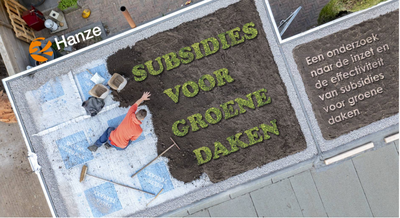Groene daken duiken steeds vaker op in het straatbeeld – van kleine postzegels op schuurtjes tot uitgestrekte groene oases op fabrieksdaken. Hoewel je ze vanaf de straat niet altijd goed kunt zien zijn ze wel hard nodig voor de leefbaarheid van dorpen en steden: ze vangen regenwater op, zorgen voor verkoeling en dragen bij aan een gezondere leefomgeving. En toch neemt de ontwikkeling van groene daken geen vaart. Veel gebouwen zijn in privébezit, waardoor gemeenten afhankelijk zijn van bewoners en bedrijven die zelf de stap zetten om een groen dak aan te leggen. Het inzetten van subsidies is daarom een populaire maatregel om groene daken aantrekkelijker te maken. Maar werken dit soort subsidies eigenlijk wel? Wie maakt er wel of niet gebruik van, hoe worden de subsidies bepaald en gecommuniceerd, en wat werkt daarin wel en juist niet? In opdracht van de Gemeente Westerkwartier doken we als Hanze met een groep studenten in dit vraagstuk. Waarom blijven aanvragen achter? Wat doen andere gemeenten met deze subsidie? En hoe krijgen we meer mensen enthousiast? Ontdek de antwoorden op al deze vragen in dit gebundelde verslag van studentonderzoeken!
DOCUMENT

This empirical study investigated the relationship between the learning climate and training participation in Dutch organizations and how subsidies and the sharing of investments in time and costs between employers and employees affect this relationship. Our analyses are based on a survey of a representative sample of 512 organizations with at least five employees in a Dutch region. Respondents replied to five statements to measure the learning climate, while training was measured through participation and intensity. We found that an organization’s learning climate is positively related to participation and intensity of training in terms of hours. However, we observe that the effect of learning climate on the number of hours of training decreases when the employer pays the costs for the training and when the training takes place during working hours. When organizations can use government subsidies, participation in training increases, and the number of hours per participant increases.
DOCUMENT

Ending subsidies for fossil fuel heating systems from 2025, and phasing out gas boilers and other fossil fuel heaters by 2040. These are just two of the outcomes of a political agreement between the EU Council and the European Parliament, which was reached on December 7, 2023. Which measures were agreed upon, and what will the implications be for the heating sector?
MULTIFILE
In our paper we want to investigate the question whether it will make sense for regions to compete for new high-tech industries to settle down in their region. The justification for giving subsidies is based on the general believe in politics that attracting high-technology firms will cause positive externalities in the sense of Arrow (1962) and of course will directly create working places and an additional tax revenue in the long run. Additionally, it is a general believe in politics that competition between regions will enhance the efficiency of local authorities and local administration. At the moment such new high technologies are bio-technology firms, ICT firms, nanotechnology firms etc.
MULTIFILE

Today, Dutch National Non-profit Sports Organizations (NNSFs) experience financial pressures. Two indications for this are described in this paper i.e. increased competition in the sports sector and changes in subsidy division. Decreasing incomes from subsidies can be compensated with either increasing incomes from a commercial domain or increasing incomes from member contributions. This last solution has been the motive for the increasing interest in the use of marketing techniques as a solution for the growing uncertainties. Many NNSFs have participated in a special marketing program in order to enlarge their marketing awareness and create a marketing strategy. This paper deals with possible impediments resulting from the implementation of the marketing strategies. It is primarily based on a literature review, however, the first results from a qualitative research to the increasing use of marketing techniques among NNSFs provides insights in the experienced impediments of NNSFs .
DOCUMENT
In deze studie zijn vier scenario’s voor een aardgasvrije warmtevoorziening in de wijk Paddepoel doorgerekend: ‘all-electric’, ‘hybride’, ‘warmtenet’ en ‘waterstof’. In deze studie is een van de meest veelvoorkomende woningtypen in de wijk, een rijtjeswoning uit de jaren ’60 of ’70, als uitgangspunt genomen. Vervolgens zijn de investeringskosten, kostenbesparing, haalbaarheid, CO2-emissiereducties en kosteneffectiviteit (indicatoren) per scenario in kaart gebracht. Hierbij zijn varianten gemaakt die isolatie, zonnepanelen en subsidies wel of niet meerekenen.
DOCUMENT

Verlengingsaanvraag lectoraat Nieuwe Energie in de Stad
DOCUMENT
In publications addressing literary reflections on Europe, little attention has been paid to emerging cultural networks, the role of EU subsidies, or literary organisations engaging writers in initiatives aimed at contemplating the challenges that the European Union faces. This dissertation aims to explain the role of new initiatives by presenting four recent, transnational literary projects as case studies: the “Literatur Express Europa 2000”; “The European Constitution in Verse”; “Narratives for Europe”; and “The Return of Europe”. The projects were analysed through an examination of three fundamental aspects: the expectations held by the cultural organisations regarding their initiatives; the cultural artefacts resulting from the projects; and the effects of the projects in the public sphere. By selecting literary projects about Europe as case studies, rather than individual authors or texts, this research allows for an interdisciplinary approach that reveals the interaction between EU politics, civil society, cultural networks, and individual authors.
LINK